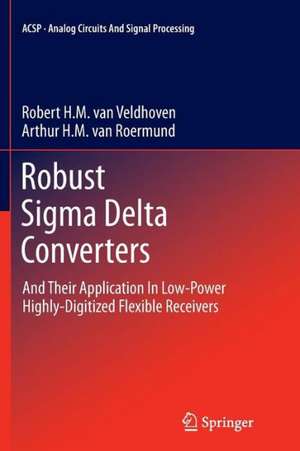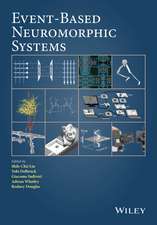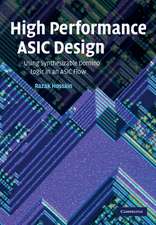Robust Sigma Delta Converters: And Their Application in Low-Power Highly-Digitized Flexible Receivers: Analog Circuits and Signal Processing
Autor Robert H.M. van Veldhoven, Arthur H.M. van Roermunden Limba Engleză Paperback – 21 apr 2013
- Quality indicators: provide a means to quantify system quality.
- Accuracy: introduction of new Sigma Delta Modulator architectures.
- Robustness: a significant extension on clock jitter theory based on phase and error amplitude error models. Extension of the theory describing aliasing in Sigma Delta converters for different types of DACs in the feedback loop.
- Flexibility: introduction of a Sigma Delta converter bandwidth scaling theory leading to very flexible Sigma Delta converters.
- Efficiency: introduction of new Figure-of-Merits which better reflect performance-power trade-offs.
- Emission: analysis of Sigma Delta modulators on emission is not part of the book
Robust Sigma Delta Converters is written under the assumption that the reader has some background in receivers and in A/D conversion.
| Toate formatele și edițiile | Preț | Express |
|---|---|---|
| Paperback (1) | 945.62 lei 6-8 săpt. | |
| SPRINGER NETHERLANDS – 21 apr 2013 | 945.62 lei 6-8 săpt. | |
| Hardback (1) | 1006.24 lei 6-8 săpt. | |
| SPRINGER NETHERLANDS – 9 feb 2011 | 1006.24 lei 6-8 săpt. |
Din seria Analog Circuits and Signal Processing
- 5%
 Preț: 902.97 lei
Preț: 902.97 lei - 9%
 Preț: 629.00 lei
Preț: 629.00 lei -
 Preț: 388.34 lei
Preț: 388.34 lei - 15%
 Preț: 636.30 lei
Preț: 636.30 lei - 15%
 Preț: 636.80 lei
Preț: 636.80 lei - 18%
 Preț: 941.82 lei
Preț: 941.82 lei - 15%
 Preț: 639.08 lei
Preț: 639.08 lei - 18%
 Preț: 918.48 lei
Preț: 918.48 lei - 15%
 Preț: 631.21 lei
Preț: 631.21 lei - 15%
 Preț: 642.03 lei
Preț: 642.03 lei - 15%
 Preț: 641.85 lei
Preț: 641.85 lei - 18%
 Preț: 887.05 lei
Preț: 887.05 lei - 18%
 Preț: 944.51 lei
Preț: 944.51 lei - 15%
 Preț: 632.55 lei
Preț: 632.55 lei - 15%
 Preț: 641.03 lei
Preț: 641.03 lei - 18%
 Preț: 836.39 lei
Preț: 836.39 lei - 15%
 Preț: 642.18 lei
Preț: 642.18 lei - 15%
 Preț: 639.90 lei
Preț: 639.90 lei - 18%
 Preț: 947.85 lei
Preț: 947.85 lei - 15%
 Preț: 642.51 lei
Preț: 642.51 lei - 15%
 Preț: 631.86 lei
Preț: 631.86 lei - 15%
 Preț: 634.49 lei
Preț: 634.49 lei - 15%
 Preț: 635.47 lei
Preț: 635.47 lei - 15%
 Preț: 640.06 lei
Preț: 640.06 lei - 15%
 Preț: 631.53 lei
Preț: 631.53 lei - 15%
 Preț: 635.65 lei
Preț: 635.65 lei - 18%
 Preț: 941.50 lei
Preț: 941.50 lei - 18%
 Preț: 1112.92 lei
Preț: 1112.92 lei - 15%
 Preț: 636.30 lei
Preț: 636.30 lei - 15%
 Preț: 633.19 lei
Preț: 633.19 lei - 15%
 Preț: 635.80 lei
Preț: 635.80 lei - 18%
 Preț: 888.01 lei
Preț: 888.01 lei - 18%
 Preț: 942.76 lei
Preț: 942.76 lei - 18%
 Preț: 1387.10 lei
Preț: 1387.10 lei - 18%
 Preț: 1115.28 lei
Preț: 1115.28 lei - 15%
 Preț: 633.68 lei
Preț: 633.68 lei - 15%
 Preț: 641.03 lei
Preț: 641.03 lei - 15%
 Preț: 638.57 lei
Preț: 638.57 lei - 15%
 Preț: 642.51 lei
Preț: 642.51 lei - 18%
 Preț: 947.85 lei
Preț: 947.85 lei - 15%
 Preț: 640.71 lei
Preț: 640.71 lei - 15%
 Preț: 640.88 lei
Preț: 640.88 lei - 15%
 Preț: 631.40 lei
Preț: 631.40 lei - 18%
 Preț: 944.19 lei
Preț: 944.19 lei - 18%
 Preț: 944.67 lei
Preț: 944.67 lei - 18%
 Preț: 942.94 lei
Preț: 942.94 lei - 15%
 Preț: 641.20 lei
Preț: 641.20 lei - 20%
 Preț: 555.53 lei
Preț: 555.53 lei - 18%
 Preț: 1003.38 lei
Preț: 1003.38 lei
Preț: 945.62 lei
Preț vechi: 1153.19 lei
-18% Nou
Puncte Express: 1418
Preț estimativ în valută:
180.97€ • 196.50$ • 152.01£
180.97€ • 196.50$ • 152.01£
Carte tipărită la comandă
Livrare economică 22 aprilie-06 mai
Preluare comenzi: 021 569.72.76
Specificații
ISBN-13: 9789400735231
ISBN-10: 9400735235
Pagini: 320
Ilustrații: XXIV, 296 p.
Dimensiuni: 155 x 235 x 17 mm
Greutate: 0.45 kg
Ediția:2011
Editura: SPRINGER NETHERLANDS
Colecția Springer
Seria Analog Circuits and Signal Processing
Locul publicării:Dordrecht, Netherlands
ISBN-10: 9400735235
Pagini: 320
Ilustrații: XXIV, 296 p.
Dimensiuni: 155 x 235 x 17 mm
Greutate: 0.45 kg
Ediția:2011
Editura: SPRINGER NETHERLANDS
Colecția Springer
Seria Analog Circuits and Signal Processing
Locul publicării:Dordrecht, Netherlands
Public țintă
ResearchCuprins
List of abbreviations.- Terminology.- List of symbols.- Nomenclature.- 1 Introduction.- 2 System quality indicators.- 3 Integrated receiver architectures for cellular and connectivity.- 4 Specifications for A/D converters in cellular and connectivity receivers.- 5 SD modulator algorithmic accuracy.- 6 SD modulator robustness.- 7 SD modulator flexibility.- 8 SD modulator efficiency.- 9 SD modulator implementations and the quality indicators.- 10 Conclusions.- A Harmonic and intermodulation distortion in an I&Q system.- B Distortion of a differential input transistor pair biased in weak inversion.- C Fourier series expansion and return-to-zero.- D Clock jitter in an I&Q system according to the TPJE clock jitter model.- References.- Index.
.
.
Notă biografică
Robert H.M. van Veldhoven was born in Eindhoven, The Netherlands, in 1972. After finishing his pre-education (HAVO) at ''Het Hertog-Jan College'' in Valkenswaard, he started to study ''hands-on'' electronics at the MTS ''Leonardo Da Vinci college'' in Eindhoven. After 2 years at the MTS, he started studying electrical engineering at the polytechnical college ''Fontys Hogescholen'' in Eindhoven. In 1996 he joined the Mixed-Signal Circuits and Systems group at Philips Research after successfully finishing his graduation project on a low-power Sigma Delta modulator for multi-meter applications. After working 3 years at Philips he started to pursue a master degree in Electronics from the Technical University of Eindhoven, which he successfully finished in 2003. After working for 10 years at Philips Research, he joined the Mixed-Signal Circuits and Systems group at NXP Semiconductor Research in Eindhoven in 2006, where he is an expert in the field of high-resolution A/D and D/A converters, and integrated circuits for instrumentation-, sensor-, audio-, and radio-systems. In 2010 he pursued a PhD degree in Electronic Engineering. Van Veldhoven holds various US patents and published various papers at leading conferences and in leading journals, and is reviewer for several professional journals and conferences. In 2004 and 2010, he was invited to give a forum presentation at the ISSCC about \sd modulators for wireless and cellular receivers.
Arthur H.M. van Roermund (SM’95) was born in Delft, The Netherlands in 1951. He received the M.Sc. degree in electrical engineering in 1975 from the Delft University of Technology and the Ph.D. degree in Applied Sciences from the K.U.Leuven, Belgium, in 1987. From 1975 to 1992 he was with Philips Research Laboratories in Eindhoven. From 1992 to 1999 he has been a full professor at the Electrical Engineering Department of Delft University of Technology, where he was chairman of the Electronics Research Group and member of the management team of DIMES. From 1992 to 1999 he has been chairman of a two-years post-graduate school for “chartered designer”. From 1992 to 1997 he has been consultant for Philips. October 1999 he joined Eindhoven University of Technology as a full professor, chairing the Mixed-signal Microelectronics Group. Since September 2002 he is also director of research of the Department of Electrical Engineering. He is chairman of the board of ProRISC, a nation-wide microelectronics platform; a member of the ICT research platform for the Netherlands (IPN); and a member of the supervisory board of the NRC Photonics research centre. Since 2001, he is one of the three organisers of the yearly workshop on Advanced Analog Circuit Design (AACD). In 2004 he achieved the ‘Simon Stevin Meester’ award, coupled to a price of 500.000€, for his scientific and technological achievements. In 2007 he was member of an international assessment panel for the Department of Electronics and Information of Politecnico di Milano, and in 2009 for Electronics and Electrical Engineering for the merged Aalto University Finland. He authored/co-authored more than 300 articles and 25 books.
Arthur H.M. van Roermund (SM’95) was born in Delft, The Netherlands in 1951. He received the M.Sc. degree in electrical engineering in 1975 from the Delft University of Technology and the Ph.D. degree in Applied Sciences from the K.U.Leuven, Belgium, in 1987. From 1975 to 1992 he was with Philips Research Laboratories in Eindhoven. From 1992 to 1999 he has been a full professor at the Electrical Engineering Department of Delft University of Technology, where he was chairman of the Electronics Research Group and member of the management team of DIMES. From 1992 to 1999 he has been chairman of a two-years post-graduate school for “chartered designer”. From 1992 to 1997 he has been consultant for Philips. October 1999 he joined Eindhoven University of Technology as a full professor, chairing the Mixed-signal Microelectronics Group. Since September 2002 he is also director of research of the Department of Electrical Engineering. He is chairman of the board of ProRISC, a nation-wide microelectronics platform; a member of the ICT research platform for the Netherlands (IPN); and a member of the supervisory board of the NRC Photonics research centre. Since 2001, he is one of the three organisers of the yearly workshop on Advanced Analog Circuit Design (AACD). In 2004 he achieved the ‘Simon Stevin Meester’ award, coupled to a price of 500.000€, for his scientific and technological achievements. In 2007 he was member of an international assessment panel for the Department of Electronics and Information of Politecnico di Milano, and in 2009 for Electronics and Electrical Engineering for the merged Aalto University Finland. He authored/co-authored more than 300 articles and 25 books.
Textul de pe ultima copertă
Sigma Delta converters are a very popular choice for the A/D converter in multi-standard, mobile and cellular receivers. Key A/D converter specifications are high dynamic range, robustness, scalability, low-power and low EMI. Robust Sigma Delta Converters presents a requirement derivation of a Sigma Delta modulator applied in a receiver for cellular and connectivity, and shows trade-offs between RF and ADC. The book proposes to categorize these requirements in 5 quality indicators which can be used to qualify a system, namely accuracy, robustness, flexibility, efficiency and emission. In the book these quality indicators are used to categorize Sigma Delta converter theory. A few highlights on each of these quality indicators are;
Robust Sigma Delta Converters is written under the assumption that the reader has some background in receivers and in A/D conversion.
- Quality indicators: provide a means to quantify system quality.
- Accuracy: introduction of new Sigma Delta Modulator architectures.
- Robustness: a significant extension on clock jitter theory based on phase and error amplitude error models. Extension of the theory describing aliasing in Sigma Delta converters for different types of DACs in the feedback loop.
- Flexibility: introduction of a Sigma Delta converter bandwidth scaling theory leading to very flexible Sigma Delta converters.
- Efficiency: introduction of new Figure-of-Merits which better reflect performance-power trade-offs.
- Emission: analysis of Sigma Delta modulators on emission is not part of the book
Robust Sigma Delta Converters is written under the assumption that the reader has some background in receivers and in A/D conversion.
Caracteristici
Extends Sigma Delta Converter theory Describes application, theory, and implementation of Sigma Delta Modulators Describes various analytical models for clock jitter and successfully verifies with measurements Shows different and competitive implementations of SDM Includes supplementary material: sn.pub/extras










